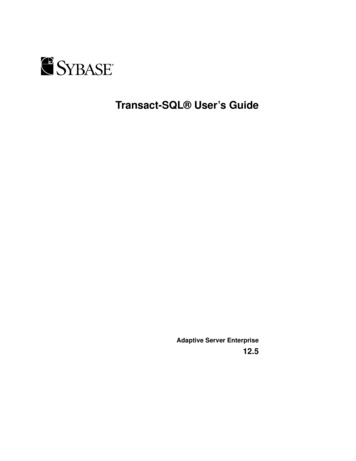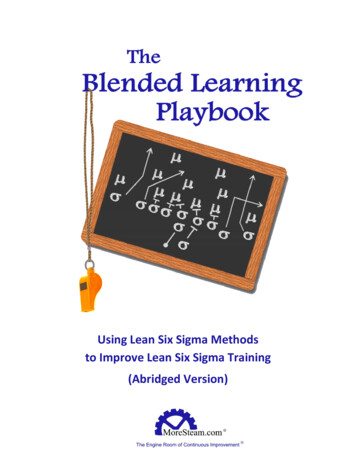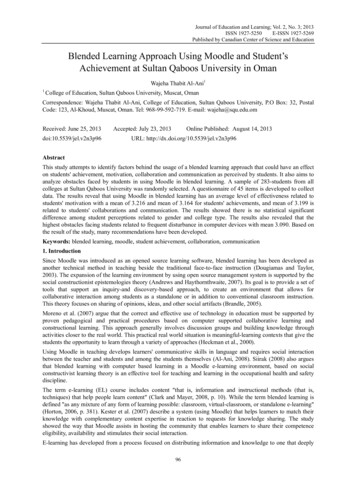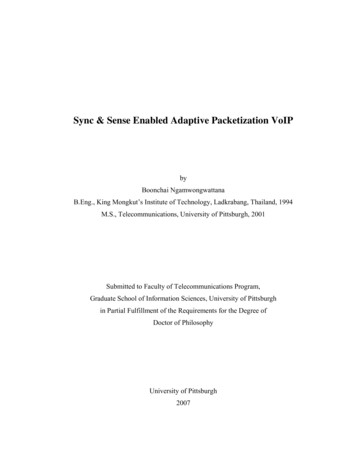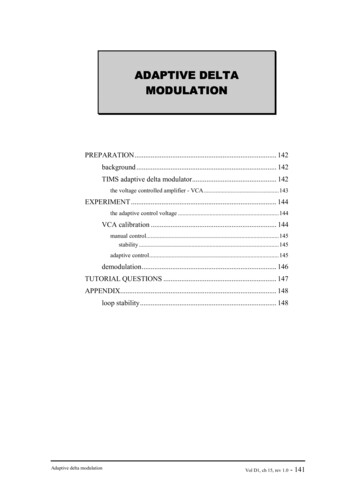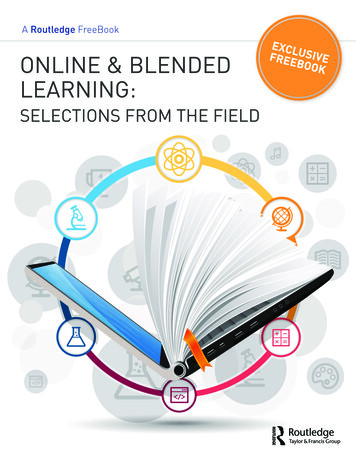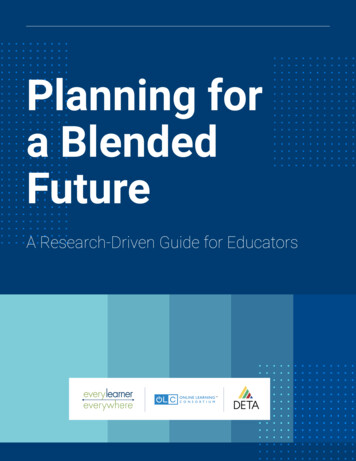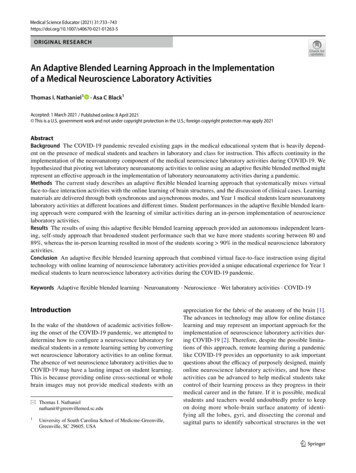
Transcription
Medical Science Educator (2021) 63-5ORIGINAL RESEARCHAn Adaptive Blended Learning Approach in the Implementationof a Medical Neuroscience Laboratory ActivitiesThomas I. Nathaniel1· Asa C Black1Accepted: 1 March 2021 / Published online: 8 April 2021 This is a U.S. government work and not under copyright protection in the U.S.; foreign copyright protection may apply 2021AbstractBackground The COVID-19 pandemic revealed existing gaps in the medical educational system that is heavily dependent on the presence of medical students and teachers in laboratory and class for instruction. This affects continuity in theimplementation of the neuroanatomy component of the medical neuroscience laboratory activities during COVID-19. Wehypothesized that pivoting wet laboratory neuroanatomy activities to online using an adaptive flexible blended method mightrepresent an effective approach in the implementation of laboratory neuroanatomy activities during a pandemic.Methods The current study describes an adaptive flexible blended learning approach that systematically mixes virtualface-to-face interaction activities with the online learning of brain structures, and the discussion of clinical cases. Learningmaterials are delivered through both synchronous and asynchronous modes, and Year 1 medical students learn neuroanatomylaboratory activities at different locations and different times. Student performances in the adaptive flexible blended learning approach were compared with the learning of similar activities during an in-person implementation of neurosciencelaboratory activities.Results The results of using this adaptive flexible blended learning approach provided an autonomous independent learning, self-study approach that broadened student performance such that we have more students scoring between 80 and89%, whereas the in-person learning resulted in most of the students scoring 90% in the medical neuroscience laboratoryactivities.Conclusion An adaptive flexible blended learning approach that combined virtual face-to-face instruction using digitaltechnology with online learning of neuroscience laboratory activities provided a unique educational experience for Year 1medical students to learn neuroscience laboratory activities during the COVID-19 pandemic.Keywords Adaptive flexible blended learning · Neuroanatomy · Neuroscience · Wet laboratory activities · COVID-19IntroductionIn the wake of the shutdown of academic activities following the onset of the COVID-19 pandemic, we attempted todetermine how to configure a neuroscience laboratory formedical students in a remote learning setting by convertingwet neuroscience laboratory activities to an online format.The absence of wet neuroscience laboratory activities due toCOVID‐19 may have a lasting impact on student learning.This is because providing online cross-sectional or wholebrain images may not provide medical students with an* Thomas I. Nathanielnathanit@greenvillemed.sc.edu1University of South Carolina School of Medicine-Greenville,Greenville, SC 29605, USAappreciation for the fabric of the anatomy of the brain [1].The advances in technology may allow for online distancelearning and may represent an important approach for theimplementation of neuroscience laboratory activities during COVID-19 [2]. Therefore, despite the possible limitations of this approach, remote learning during a pandemiclike COVID-19 provides an opportunity to ask importantquestions about the efficacy of purposely designed, mainlyonline neuroscience laboratory activities, and how theseactivities can be advanced to help medical students takecontrol of their learning process as they progress in theirmedical career and in the future. If it is possible, medicalstudents and teachers would undoubtedly prefer to keepon doing more whole-brain surface anatomy of identifying all the lobes, gyri, and dissecting the coronal andsagittal parts to identify subcortical structures in the wet13Vol.:(0123456789)
734neuroscience laboratory activities. However, being forcedto think and provide a different platform for learning mayactually be quite beneficial for both students and teachers.Therefore, online and virtual neuroscience laboratory activities during the COVID‐19 crisis may serve many goals; forexample, this approach might help investigate whether suchonline activities are effective in enhancing student performance compared with in-person wet laboratory neuroscienceactivities. Moreover, it is important to know whether theseonline and virtual neuroscience laboratory activities can besuitably integrated into the design of a medical neurosciencecourse that can be used to carefully guide students through alearning expedition, rather than simply being made availableas another resource, for learning during a pandemic.While the pandemic pushed many medical schools intodifferent directions with innovative ideas in delivering neuroscience laboratory instruction in an online setting, it isvery important to take advantage of the resources that areavailable to implement those new ideas. For instance, it isimportant to evaluate whether those new ideas or resourcesare effective. This is because while generating ideas is onegreat advantage of working with an integrated team of neuroscientists, transforming the good ideas to help medicalstudents perform well in this challenging time may lead toimportant benefits for students. One of the adjustments forevery neuroscience faculty member in this challenging timeis learning to use digital technology and communicate tostudents entirely virtually in the implementation of neuroscience laboratory activities. Therefore, while there arechallenges in implementing neuroscience laboratory activities during the shutdown, there are also opportunities todevelop a unique model of blended learning that comprisesthe blending of online activities with digital technology. Thismodel represented an adaptive blended learning that useddigital technology infrastructure that supported online learning, where activities can be designed to adapt in response toan individual learner’s needs [3–6].Adaptive learning refers to a kind of responsiveness [7];for example, the National Academy of Science interpretsthe phrase as “How people learn” or “learner-centered”and this responsiveness represents one of the fundamentalqualities of effective learning [8]. Thus, adaptive learningbuilds on what is known about an individual learner to systematically adjust content or learning activities [3, 3–12].Medical students are known to be quite sophisticated inusing digital technology in an integrated medical curriculum [13–15]. In addition, they are also accustomed to selfstudy and working independently at their own pace [16–20].Therefore, an adaptive blended learning approach will suitthe particular needs of medical students, especially in thecontext of geographical location and during the COVID-19pandemic. Consequently, knowledge of what is known aboutthe technological skills of medical students in an integrated13Medical Science Educator (2021) 31:733–743medical curriculum could subsequently be used to developadaptive learning activities for medical students in a timeof pandemic.While it is important to view blended learning as a continuum with a form of distance learning, “fully online withno classroom teaching,” at one end and “teaching with notechnology at all on the other end [21, 22],” there shouldbe adaptability to reflect the goal of controlling the paceof learning, time, place, or geographic location especiallyduring a pandemic [23]. In this context, an adaptive blendedlearning approach represented a fundamental shift in a neuroscience laboratory instruction method that blended digital technology with online activities to provide a uniquelearning experience in a time of pandemic. In the adaptiveblended learning pedagogy, the digital technology replacedface-to-face learning with a virtual interaction, and theonline activities gave students some element of control overtheir learning. This adaptation provided an individualizedcustomized, fluid schedule allowing medical students tocombine virtual learning [24, 25] with online activities forstudent-centered neuroscience laboratory instruction.In this study, we describe the implementation of an adaptive blended learning pedagogy by pivoting brain dissection from in-person neuroscience laboratory activities to amodified adaptive blended learning approach that providesa virtual laboratory format of interactive neuroanatomyactivities, clinical case discussion sessions, online images,and a virtual discussion platform that allowed interactionbetween faculty and students. We compared performance insummative examinations in the adaptive blended learningactivities with previous academic performance when neuroscience laboratory activities were implemented throughin-person neuroscience laboratory settings. This comparisonallowed us to determine whether the adaptive blended learning of neuroscience laboratory activities enhanced studentperformance when compared with the results of in-personneuroscience laboratory activities.MethodsParticipantsA total of 102 first year medical students in years 2019 and2020 at the University of South Carolina School of MedicineGreenville who took the medical neuroscience course alsoparticipated in the neuroscience laboratory activity. In 2019,there were 57 female students, compared with 46 male students. In 2020, there were 58 female students, comparedwith 46 male students involved in the adaptive blended learning neuroscience laboratory activities. Average class age forboth years was 23.0. The average score for admitted studentson the Medical College Admission Test (MCAT) score for
Medical Science Educator (2021) 31:733–7432019 was at the 71st percentile, while that of 2020 was atthe 73rd percentile. The average GPA for admitted studentsin 2019 was 3.66, while the average GPA for 2020 was 3.65.The study was approved by the Institutional Review Board(IRB), and all participants consented to participate.735answered related clinical questions pertaining to the clinicalproblem. For the graded examinations, students were testedon their knowledge of how to identify gross anatomicalstructures and radiological images in addition to answeringclinical vignette-style questions in the effect of lesions on thepatient’s signs, symptoms and on the result of clinical tests.Description of the Typical Wet NeuroscienceLaboratory Activities and Clinical Case DiscussionDescription of Adaptive Blended Learning ActivitiesMedical neuroscience is a 4-week course taught to medicalstudents during the second semester of the first year afterthe Structure and Function 1 and 2 modules. In the implementation of the course, there were a variety of learningactivities including active lectures, class discussions, smallgroup sessions, clinical case presentations, and laboratorysessions in the form of cadaveric dissection. For the laboratory activities, medical students spent a total of 6 h duringwet neuroanatomy laboratory activities in mandatory sessions. Students were able to spend additional time outsideof the mandatory sessions for individual laboratory reviewof materials. The neuroanatomy laboratory portion of thecourse included detailed examination of the surface anatomyof the brain, dissection to identify subcortical structures,clinical case discussion, and review of neuroimaging in bothcoronal and sagittal sections. For the implementation of eachlaboratory session, there was a general description and anoverview of specific objectives for the session, and studentswere provided with instructions for each of the laboratoryactivities (Table 1). The course assessment was comprisedof five laboratory quizzes that accounted for 12% of thefinal grade, a laboratory and clinical correlation examination that accounted for 36% of the final grade, and a writtenexamination that accounted for 52% of the final grade. Ingeneral, the laboratory component of the course comprised48% of the total grade. During the dissections, a group of sixto eight students shared a cadaver and rotated turns to dissect the brain under the supervision of neuroscience faculty(Neuroscience) and clinicians (Neurologists and Neurosurgeons). An important element of the neuroscience laboratoryactivity was the clinical case presentation sessions. Clinicalcases were built on structures identified in the wet neuroanatomy laboratory to further reinforce the clinical relevanceof specific neuroanatomical targets during the neuroscienceclinical case discussion session. During these presentations,students were divided into small groups, and each group wasprovided with a clinical case that related to a componentof neuroanatomy that was learned during a neuroanatomywet laboratory experience. Students were provided with anopportunity to discuss the cases among their small groupsand solve the problems by identifying the effect of specificlesions on specific structures based on the patient’s clinicalpresentation. After the small group meeting, students thenpresented their analysis of the case to the whole class andAt the University of South Carolina School of MedicineGreenville, the neuroscience laboratory activities werechanged to online instruction in the 2020 academic yeardue to the COVID-19 pandemic that resulted in the shuttingdown of universities. While there were challenges in theadjustment, we implemented the same laboratory activitiesand volume of materials that we have maintained over theyears. The only change for this year is that all activities wereaccomplished online through the adaptive blended learningmodel.For the laboratory portion of the course which requireddetailed examination and identification of structures in thesurface anatomy of the brain and the anatomy of subcortical structures, students were provided with neuroanatomicalinteractive virtual activities. Implementation of each laboratory session in the adaptive blended learning model involveda general description and an overview of specific objectivesfor the session, and students were provided with instructionsfor each of the laboratory activities.From the student perspective, the neuroanatomical interactive virtual activities shifted all the lab activities, contents,and instructions to the control of the student allowing eachstudent to manage the pace with the ability to pause, goback, or skip forward through online content as he or shewanted during implementation of the different activities. Theinteractive online activities replaced the traditional handson-laboratory neuroanatomical activities that had been themainstay of our neuroscience laboratory activities over theyears for year one medical students. The neuroanatomicalinteractive virtual activities were implemented by studentsusing the “Digital Neuroanatomy” software developed byLeichnetz [53]. During the online activities, students wereable to interact with several human brain dissections withthe virtual brain, which can be resized and rotated in alldirections, and certain areas can be selected allowing students to identify structures of particular interest. Moreover,students could select the particular dissection of interestand view the brief animated gifs of the actual dissectionswhich demonstrated how each virtual brain was prepared.Multiple learning formats were provided comprising written instructions, video tutorials, and demonstrations of braindissection, offering students a self-paced, interactive reviewof structures and functions of the brain. In addition, practice questions were provided to help apply learned concepts13
736to clinical application. In most cases, students chose thetime at which they performed their neuroscience laboratoryactivities in their different locations. This enabled facultymembers to have time to interact with each student throughemail communication and the online interactive discussionplatform on Canvas.During virtual interactions, faculty members appearedin-person in an empty classroom (Fig. 1) to discuss clinical cases using WebEx/Panopto, allowing virtual interactions with students and the opportunity to respond to studentquestions. During these presentations, each clinical casewas related to a component of neuroanatomy and allowedstudents to solve the problems by identifying the effect ofspecific lesions on specific structures based on the patient’sclinical presentation. Therefore, clinical cases were built onstructures that students identified in their online interactiveactivities concerning the identification of surface and subcortical structures. While the clinical sessions were led byfaculty members, students participated virtually in the clinical case sessions through WebEx and asked questions forclarification of specific clinical concepts.After the presentation, a detailed description of eachclinical case presentation was posted online on Canvas forstudents, and all cases were recorded on Panapto/WebEx andposted online an hour after each case presentation. Transferring the recorded case discussions online did much ofthe heavy lifting in terms of saving time which would haveFig. 1 The empty class room is shown while faculty members meet todiscuss clinical cases and interact with students virtually. Panapto andWebEx platforms were very effective for live or virtual interaction inthe discussion of clinical cases. This was very helpful in providingclinical relevance to learned neuroscience concepts and in the periodically interactive discussion platform. The different cases were discussed by faculty members to further reinforce the clinical relevance13Medical Science Educator (2021) 31:733–743been used in creating small group activities and deliveringclinical case sessions in the classroom. The time saved permitted providing support on an as-needed basis through individual interactive tutoring sessions on the Canvas platform.This provided additional opportunity for students to reviewessential content, ask questions, and go over problems attheir own pace. Therefore, the adaptive blended learningmodel offered our faculty members and students increasedflexibility because online learning was helpful in deliveringlaboratory neuroanatomy instruction while digital technology played a major role in the clinical case discussion. TheCanvas platform allowed faculty members to track studentactivities and progress in understanding of materials in theclinical case discussion and online activities. In general, weblended the online interactive neuroanatomy activities withvirtual or live interactions to provide an integrated learningexperience with appropriate level and topic for all activitiesin the neuroscience laboratory.Data AnalysisStudents had a weekly laboratory quiz assessment during all4 weeks of the neuroscience module. The format of the laboratory quizzes involved identification of surface anatomyand subcortical structures using the neuroanatomy interactive software and clinical vignette style questions similarto the format used by questions on the National Board ofof specific neuroanatomical targets identified by students in theironline activities. During the clinical case discussion by faculty members, online discussions on the Panapto and WebEx platform werealso ongoing allowing virtual interaction with students, and real-time.Each session was recorded on Panopto and sent to students one hourat most after each lecture
Medical Science Educator (2021) 31:733–743737100.00%**% of students .00%20.00%10.00%0.00%% questions performing at a point biserial 0.25.Yr.2019% questions items performing at a pointbiserial 0.00Yr.2020Fig. 2 Item performance measures for summative questions during the in-person (2019) and the adaptive blended learning sessions (2020)Medical Examiners (NBME) STEP 1 Examination. Theclinical vignette questions tested materials in the clinicalcase discussion sessions that were recorded on Panopto/WebEx and posted on Canvas for students. We used thesame examination format for the laboratory quizzes andthe final laboratory exam. All proctoring was done usingproctoring software developed by Examsoft Worldwide INCwas used. The same set of questions used in 2019 were alsoused in 2020 for all examinations. The format for standard item analysis including the difficulty index and biserialvalues were calculated for each of the test questions. Thisanalytical tool evaluated the performance of questions usedon both laboratory quizzes and the final laboratory examination. The reliability of the examination was determinedusing the KR20 (Kuder–Richardson Formula 20) which isan index of the internal consistency reliability [26]. Valuesfor KR20 generally range from 0.0 to 1.0, with higher values representing a more internally consistent and reliabletest capability of discriminating between students who hada higher understanding of the test material versus those witha poorer understanding. A KR20 value of 0.5 or higher is agood threshold value for determining whether or not a testis reliable [27]. The KR20 is calculated using the equationbelow;kx(1 KR20 k 1 kpiqii 1𝛿2x)and 𝛿 2 x 1 n(Xi 𝜇)2i 1nAll summative questions were mapped to each of the module level objectives. The mean percentage of performancefor each of the module level objectives was computed for2019 during wet lab neuroanatomy laboratory activities andin-person small group clinical case discussion and for 2020involving flexible blended learning of all the materials. Normality of data distribution was determined using ShapiroWilk’s test (P 0.05). Student’s t-test (two-tailed) wasTable 1 Learning objectives for the integrated medical neuroscience courseObj #Learning objectives123Explain the biochemical processes that are important in the integrated functioning of the nervous system in complexDescribe the development and structure of major components of the nervous system at the macroscopic, microscopic, andmolecular levelsCorrelate the structure of essential components of the nervous system to their physiological functionsIdentify and correlate clinical gross anatomical features of the nervous system using common analytic and imaging modalitiesIdentify cross sectional anatomical features of the nervous systemCorrelate spatial relationships and orientation of anatomical features of the nervous systemExplain clinical observations following lesions of structures and functional pathways of the nervous system456713
738Medical Science Educator (2021) 31:733–743used to determine the significance of differences between2019 and 2020 for the final summative laboratory examination. This analysis compared differences in student performance between the adaptive only blended learning andin-class clinical case discussion or wet neuroscience laboratory activities. Since student performances were spreadbetween 70–79%, 80–89%, and 90% for both classes, weused ANOVA with repeated measures or within-subject andthis enabled us to make broad comparisons for 70–79%,80–89%, and 90% for both classes. Post hoc analysis wasused to determine significant differences between the performance categories in the adaptive blended learning andthe in-person activities. Statistical significance was established at P 0.05. All statistical analyses were performedutilizing SPSS statistical package, version 25.0 (SPSS Inc.,Chicago, IL).ResultsThe results for the biserial analysis of students’ performance in the test questions are presented in Fig. 2. Theresults indicate high discrimination for test questions forthe final summative exams for both years, and they werenot significantly different (*,**P 0.05). The results forthe reliability (KR20) of the laboratory quizzes and finalexaminations are shown in Table 2. As shown in the table,KR20 values for the laboratory quizzes ranged between 0.18and 0.69 for 2019 and 0.26 and 0.52 for 2020. The KR20value was higher in 2020 (0.80) than 2019 (0.70), indicatingthe stronger reliability of the final laboratory examinationsin the adaptive blended learning sessions when all activities were delivered online. The mean score achieved in theexaminations was broken down by each of the seven objectives and presented in Fig. 3. A direct comparison using thetwo-tailed, paired Student’s t-test revealed that students’ performances on objectives 1, 2, 3, 4, and 5 were significantlyhigher in 2019 (P 0.001) when compared with 2020.However, objectives 6 and 7 were not significantly different(P 0.05) for 2019 and 2020. A direct comparison of student performance between 2019 and 2020 revealed a higherTable 2 The Kuder–Richardson Formula 20 (KR20) tests for the reliability of the formative examinations. The formative examinationshad KR20 values that range between 0.19 and 0.90 for 2019 and 0.58Quiz 1Quiz 2Quiz 3Quiz 4Quiz 513performance in 2019 (M 92, SD 0.15) when comparedwith 2020 (M 90, SD 0.11), t(101) 2.66, P 0.009).ANOVA with repeated measures found a significant difference among students in the different performance categories between 70–79, 80–89, and 90 (F(2,399) 9.996,P 0.0471). Post hoc analysis revealed a significant difference (P 0.05) among students in performance categoriesfor 2019 and 2020 (Fig. 4).DiscussionThree major findings arise from this study. First, the KR20value was higher in 2020 than 2019, indicating the strengthand reliability of the final laboratory examinations in theadaptive blended learning method when all activities weredelivered online compared with the in-person learning ofneuroscience laboratory activities. Also, the biserial analytical tool revealed high discrimination, and an acceptablelevel of difficulty. This tool provided a suitable mechanismfor validating questions and testing the performance of thesame questions used in 2019 and 2020 examinations. Second, student performance was significantly higher in six ofthe seven module objectives for 2019 when compared with2020. Third, students’ performances in the final laboratorysummative examination were higher in 2019 than 2020.This result suggested a better performance in the in-personneuroscience laboratory activities. Finally, the stronger performance in 2019 was mainly due to 70% of the studentsscoring 90%, whereas in 2020, the scores were morebroadly distributed between students that scored 80–89%and 90%. These findings reveal that the in-person neuroscience laboratory activities which involved the dissectionof the brain during wet neuroanatomy laboratory activitiesand small group discussion of clinical cases were associatedwith a better performance when compared with the adaptiveblended learning of all the materials.In 2019 (in-person learning), 70% of the studentsscored 90% while 2% scored between 70 and 79. Studentswho scored 90% in the summative examination reflecthigh performing students, and the in-person wet laboratoryand 0.88 for 2020. The scores for both years were high, indicating thestrong reliability of the formative examinationsYr 2020Mean S.EYr 2019Mean S.EP-value2019 KR 202020 KR 2098.12 0.1399.13 0.1794.76 0.1596.98 0.2193.97 0.2099.36 0.1699.37 0.2494.29 0.1677.30 0.2491.63 0.18 0.05 0.05 0.05 0.05 0.050.190.180.610.630.340.280.260.520.290.33
Medical Science Educator (2021) 31:733–743739% of students Performance100**95**90***************8580Objective 1 Objective 2 Objective 3 Objective 4 Objective 5 Objective 6 Objective 7Yr 2019Yr 2020Fig. 3 Percentage mean scores achieved on the summative examinations for each of the eight objectives. Number of medical students inthe 2019 (n 102) during the blended learning activities comparedwith 2020 adaptive flexible blended learning of all materials in anonline format (n 102)neuroscience activities and clinical case discussion sessionformat may have been more favorable to these sets of students. In the in-person neuroscience laboratory activities,students applied the information they learned in the neuroscience lecture sessions about the anatomy of the brain toan actual cadaveric brain. They worked together in smallgroups, interacted, and discussed with one another aboutidentified different structures on the cadaveric brain. In addition, during the weekly wet neuroanatomy laboratory sessionthat involved both biomedical science faculty members andclinicians, students had the opportunity to interact with clinicians who shared clinical cases related to the neuroanatomyof structures observed on the cadaveric brains. Cliniciansanalyzed clinical cases that they diagnosed related to specificstructures learned and highlighted their clinical relevance.Therefore, analyzing clinical cases also during cadavericbrain dissection in the wet neuroanatomy laboratory activities probably provided a suitable format for high-performingstudents especially in processing-related clinical neuroscience concepts. Medical students are specifically known toshow preference to learning materials that emphasize clinical relevance that they deem relevant to their future careers[28–30]. Therefore, it is possible that the presence of clinicians in the dissection laboratory during the wet neuroanatomy laboratory activities was very helpful in emphasizingthe clinical relevance of identified structures. Moreover, thereinforcement of concepts that occurred through the identification of structures in the wet neuroanatomy laboratoryactivity during the weekly clinical correlates or case discussion sessions presented by biomedical science faculty members played a major role in further simplifying the learnedconcepts. This reinforcement enables the immediate learningof the association between structures and its applicabilityto a particular neurologic disease [31–37]. This format wasprobably very helpful to low- and high-performing studentsresulting in more students scoring 90% and fewer studentsscoring less than 70% in
during a pandemic [23]. In this context, an adaptive blended learning approach represented a fundamental shift in a neu-roscience laboratory instruction method that blended digi- . a virtual laboratory format of interactive neuroanatomy activities, clinical case discussion sessions, online images, and a virtual discussion platform that .
